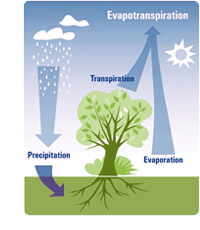Evapotranspiration
Understanding the way your plants function helps provide the right amount of water to ensure a healthy landscape and maximizes the efficiency of water applied to your landscape.
One way to do this is by using local weather conditions to help determine how much water your lawn and plants need to maintain healthy growing conditions.
 The Basics Of How Plants Function
The Basics Of How Plants Function
Just as you release water vapor when you breathe, plants do too! It’s called transpiration. When plants transpire faster than water is being replaced, they can wilt or die. Similarly, soils also lose moisture through evaporation.
Combine the two and you’ve got Evapotranspiration, or ET, which is the combination of water lost from the soil through evaporation and from plants through transpiration. The amount of water lost through ET is equal to the amount of water that must be replaced to maintain healthy growing conditions.
Just remember:
- ET values are calculated from local weather conditions to help you determine how much water is needed for your landscape.
- ET changes with local weather conditions.
- ET is affected by amount of sun, wind and air temperatures.
- ET varies for different types of plants.
So, Why Are We Talking About It?
Here in the Portland metro area, water use can more than double in the summer months. Unfortunately, our usage increases at a time when there is less water available to us.
By making a few simple changes to your watering routine you can make a big difference for your plants and your pocketbook.
How Are Evapotranspiration and The Weekly Watering Number Related?
The Consortium contracts with a weather forecasting service to provide a free weather forecast and Weekly Watering Number each Thursday. The Weekly Watering number is derived that week’s evapotranspiration number.
